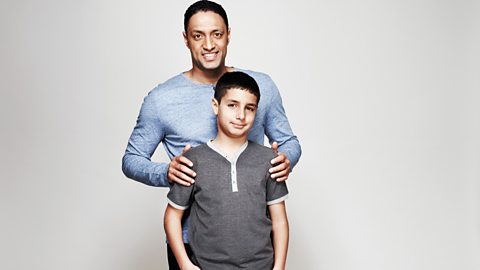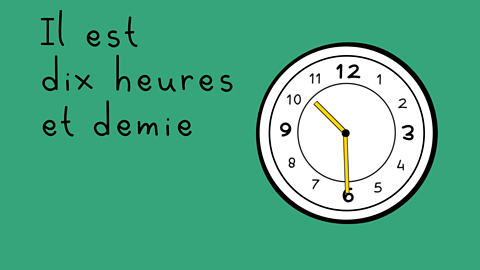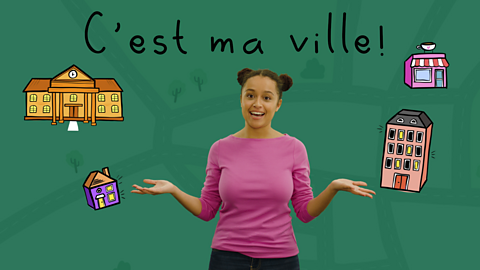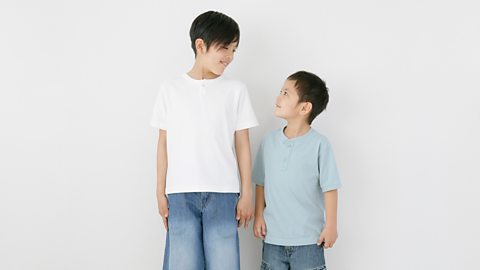Describing people in French
When you’re describing how you or other people look or are - then être - the verb to be is a good place to start.
Je suis - I am or elle est - she is.
Je suis grand - I am tall.
Elle est petite - She is small.
Je suis sportif - I am sporty.
Elle est contente - She is happy.
Then it’s good to be able to say what people have using the verb avoir - to have.
j’ai - I have
elle a - she has.
J’ai les cheveux longs - I have long hair.
Elle a les yeux bruns - She has brown eyes.
Then you can say what you wear using porter - to wear.
je porte - I wear.
elle porte - she wears.
Je porte des lunettes - I wear glasses.
Elle porte un foulard - She wears a headscarf.
So with être - to be, avoir - to have or porter - to wear you can say a lot about yourself or other people.
Describing people’s height
To describe people’s size, use a form of être (to be) and then the adjective, which usually changes its ending depending on whether the person is masculine or feminine.
- Mon père est grand - My dad is tall.
- Ma mère est grande - My mum is tall.
- Ma sœur est de taille moyenne - My sister is medium height.
- Mon demi-frère est petit - My step-brother is short.
- Ma grand-mère est petite - My grandmother is short.

Image caption, Mon père est grand
1 of 5
You can use intensifiers (words that add ‘force’ to an adjective) such as très (very) and assez (quite) to add more information.
- Je suis très grand(e) - I am very tall.
- Mon grand-père est assez petit - My grandfather is quite short.
Comparing people’s heights
To compare two people, use the following sentence structure:
| Person one + a form of être (to be) | more / less + adjective | than/as | person two |
|---|---|---|---|
| Je suis (I am) | plus grand(e) (taller) | que (than) | mon frère (my brother) |
| Ma sœur est (My sister is) | moins grande (less tall / not as tall) | que (than/as) | ma mère (my mum) |
Describing hair
To talk about your hair, use a form of avoir (to have), followed by les cheveux (hair) and then give the colour or another adjective to describe your hair.
- J’ai les cheveux bruns - I have brown hair.
- Il a les cheveux bruns et frisés - He has brown, curly hair.
If you want to use more than one adjective to describe your hair, use et before the last adjective:
- J’ai les cheveux blonds, longs et bouclés - I have long, blond, wavy hair.
The adjectives all need to have an ‘s’ on the end, as les cheveux is masculine and plural, except roux and gris, as they don’t change when masculine and plural.
| French | English |
|---|---|
| j'ai les cheveux … | I have … hair |
| il / elle a les cheveux … | he / she has … hair |
| bruns | brown |
| noirs | black |
| roux | red / ginger |
| blonds | blond |
| gris | grey |
| longs | long |
| courts | short |
| raides | straight |
| bouclés | wavy |
| frisés | curly |
Describing eye colour
To talk about eye colour, use j’ai (I have) or il a/elle a (he has/she has), followed by les yeux (eyes) and then give the colour.
The adjectives all need to have an ‘s’ on the end, as les yeux is masculine and plural, except marron, noisette and gris, as they don’t change when used in the masculine and plural.
- J’ai les yeux verts - I have green eyes.
- J’ai les yeux marron - I have brown eyes.
| French | English |
|---|---|
| j’ai les yeux … | I have … eyes |
| il / elle a les yeux … | he / she has … eyes |
| bleus | blue |
| marron | brown |
| verts | green |
| gris | grey |
| noisette | hazel |
Describing other features
There are lots of other things you can say about someone’s appearance. Here are a few more examples:
| French | English |
|---|---|
| j’ai des taches de rousseur | I have freckles |
| je porte des lunettes | I wear glasses |
| je porte le hijab / je porte le voile | I wear a hijab / headscarf |
| je porte un turban | I wear a turban |
| il a une barbe | he has a beard |
| il a une moustache | he has a moustache |
| il est chauve | he is bald |
Describing personalities
There are lots of adjectives you can use to talk about people’s personalities.
Most adjective endings change depending on whether the person you are talking about is male or female. Usually, you add an ‘e’ to the adjective to describe a female person:
- Mon copain, qui s’appelle Nabil, est amusant et très bavard - My (male) friend, Nabil, is funny and very chatty.
- Ma copine, qui s’appelle Anya, est amusante et très bavarde - My (female) friend, Anya is funny and very chatty.
Sometimes, you need to change the last consonant and add an ‘e’ to make an adjective feminine. With some adjectives, you have to double the consonant and add an ‘e’.
- Mon copain, qui s’appelle Nabil, est gentil et très sportif - My (male) friend, Nabil, is kind and very sporty.
- Ma copine, qui s’appelle Anya, est gentille et très sportive - My (female) friend, Anya is kind and very sporty.
Some adjectives don’t change when they are feminine.
- Mon copain, qui s’appelle Nabil, est sympa et très drôle - My (male) friend, Nabil, is nice and very funny.
- Ma copine, qui s’appelle Anya, est sympa très drôle - My (female) friend, Anya is nice and very funny.
Here are some great adjectives you can use to describe people’s personalities:
| Masculine | Feminine | English |
|---|---|---|
| amusant | amusante | funny / fun |
| bavard | bavarde | chatty |
| intéressant | intéressante | interesting |
| strict | stricte | strict |
| sportif | sportive | sporty |
| créatif | créative | creative |
| travailleur | travailleuse | hard-working |
| paresseux | paresseuse | lazy |
| ennuyeux | ennuyeuse | boring |
| gentil | gentille | kind |
| sympa | sympa | nice |
| drôle | drôle | funny |
Quiz
Watch the video and find out how much you know about describing people in French in this short quiz.
MICHEL: Aah, merci….
AMÉLIE: Je suis très contente d'être dans la nouvelle classe.
MICHEL: **Ah oui, moi aussi je suis content.**
AMÉLIE: **Oui. Il y a de nouveaux étudiants cette année.**
MICHEL: C’est vrai. Tu as rencontré Georges?
AMÉLIE: Ahhh… Georges?
MICHEL: **Oui. Il est assez grand avec les cheveux bruns. Tu le connais?**
AMÉLIE: Ah oui, j’ai rencontré Georges. Il est très sympa.
MICHEL: **C’est lui.**
AMÉLIE: C’est le frère de Françoise. Tu connais Françoise?
MICHEL: **Oui, Je la connais. Elle aussi est très sympa.**
AMÉLIE: Tu sais que Georges and Françoise sont jumeaux?
MICHEL: Non! Ce n’est pas vrai!
AMÉLIE: **Oui c’est vrai.**
MICHEL: Elle a les cheveux roux et des taches de rousseur.
AMÉLIE: Et Georges a les cheveux bruns et les yeux bleus.
MICHEL: Elle est travailleuse …
AMÉLIE: **Tu as raison.**
MICHEL: Ils sont si différents. Françoise est silencieuse et …
AMÉLIE: **… et Georges est bavard.**
MICHEL: J’aime beaucoup Georges.
AMÉLIE: **Moi aussi. Je l’aime beaucoup.**
MICHEL: **C’est Georges… Allô? Oh bonjour Georges. Tu veux venir chez Amélie? Je suis ici avec elle.**
MICHEL: C’est Georges! Il vient maintenant.
AMÉLIE: Super - je suis contente! Georges est trop drôle!
Translation :
MICHEL: Ah, thanks.
AMÉLIE: I’m really happy to be in the new class.
MICHEL: Ah yes, I’m happy too.
AMÉLIE: Yes. There are some new students this year.
MICHEL: It’s true. Have you met George?
AMÉLIE: Errr … George?
MICHEL: Yes. He’s fairly tall with brown hair. Do you know him?
AMÉLIE: Oh yes, I’ve met George. He’s very nice.
MICHEL: That’s him.
AMÉLIE: He’s Francoise’s brother. Do you know Francoise?
MICHEL: Yes, I know her. She’s also really nice.
AMÉLIE: You know that George and Francoise are twins?
MICHEL: No! Really?
AMÉLIE: Yes, it’s true.
MICHEL: She has red hair and freckles.
AMÉLIE: … And George has brown hair and blue eyes.
MICHEL: She is hard-working …
AMÉLIE: You’re right.
MICHEL: They are so different. Francoise is quiet and …
AMÉLIE: … and George is chatty.
MICHEL: I really like George.
AMÉLIE: Me too. I like him a lot.
MICHEL: (To Amelie) It’s George. Hi, hello George. Do you want to come over to Amélie’s house? I’m here with her ….
MICHEL: It’s George. He’s coming now.
AMÉLIE: Great! I'm happy. George is too funny!
GCSE exam dates 2025
Find out everything you need to know about the 2025 GCSE exams including dates, timetables and changes to exams to get your revision in shape.

More on Topics
Find out more by working through a topic
- count4 of 9

- count5 of 9

- count7 of 9




